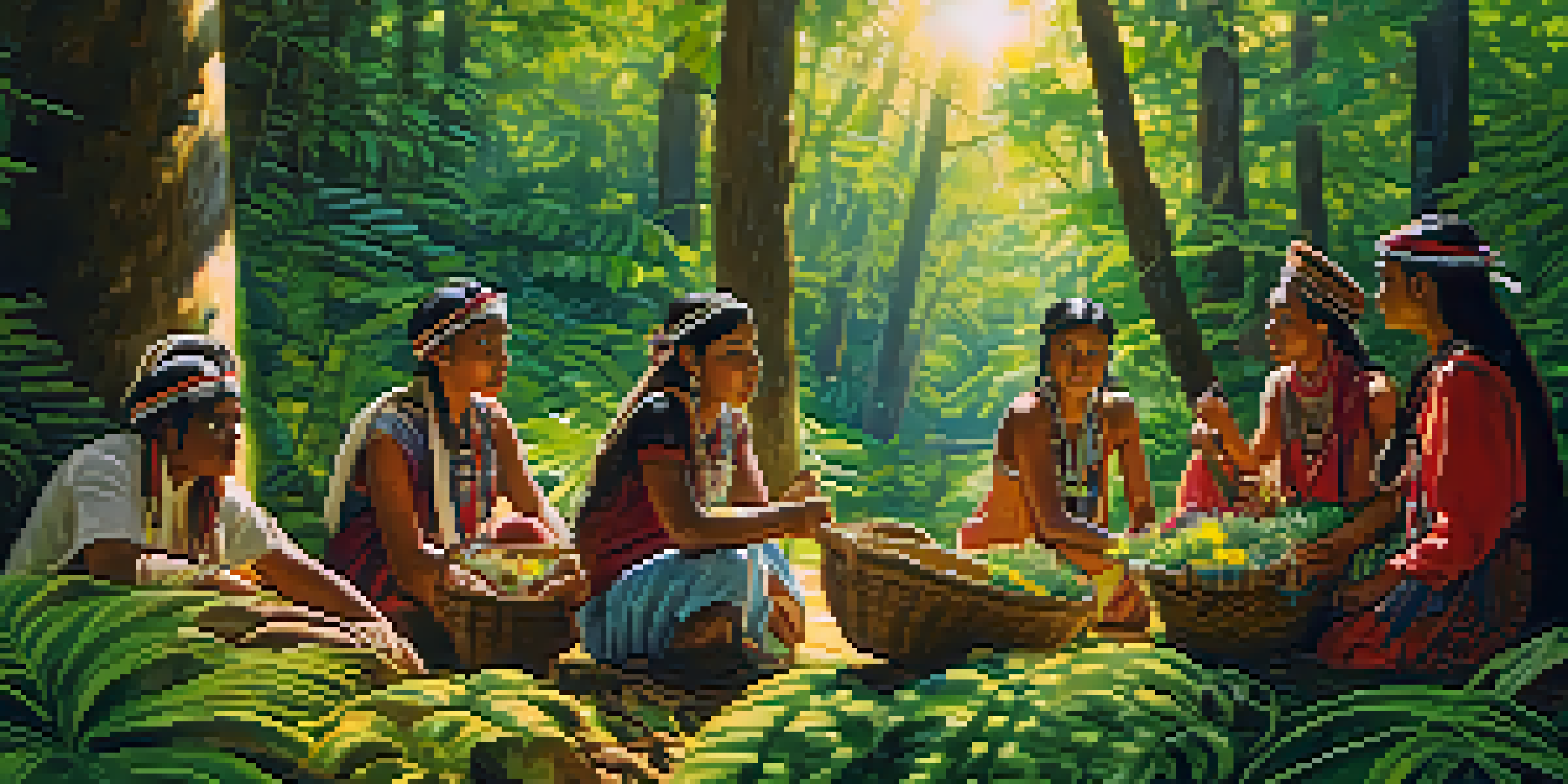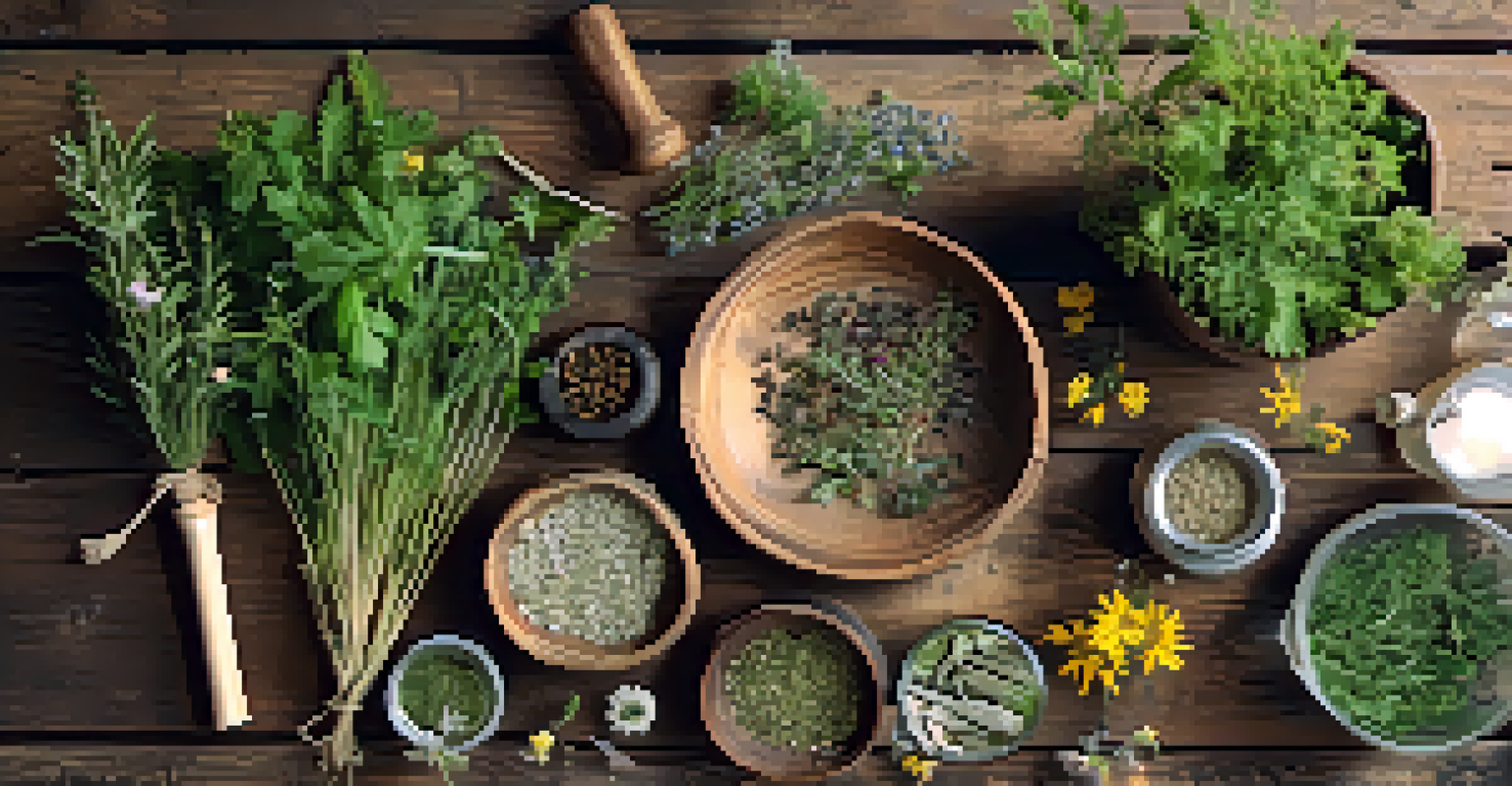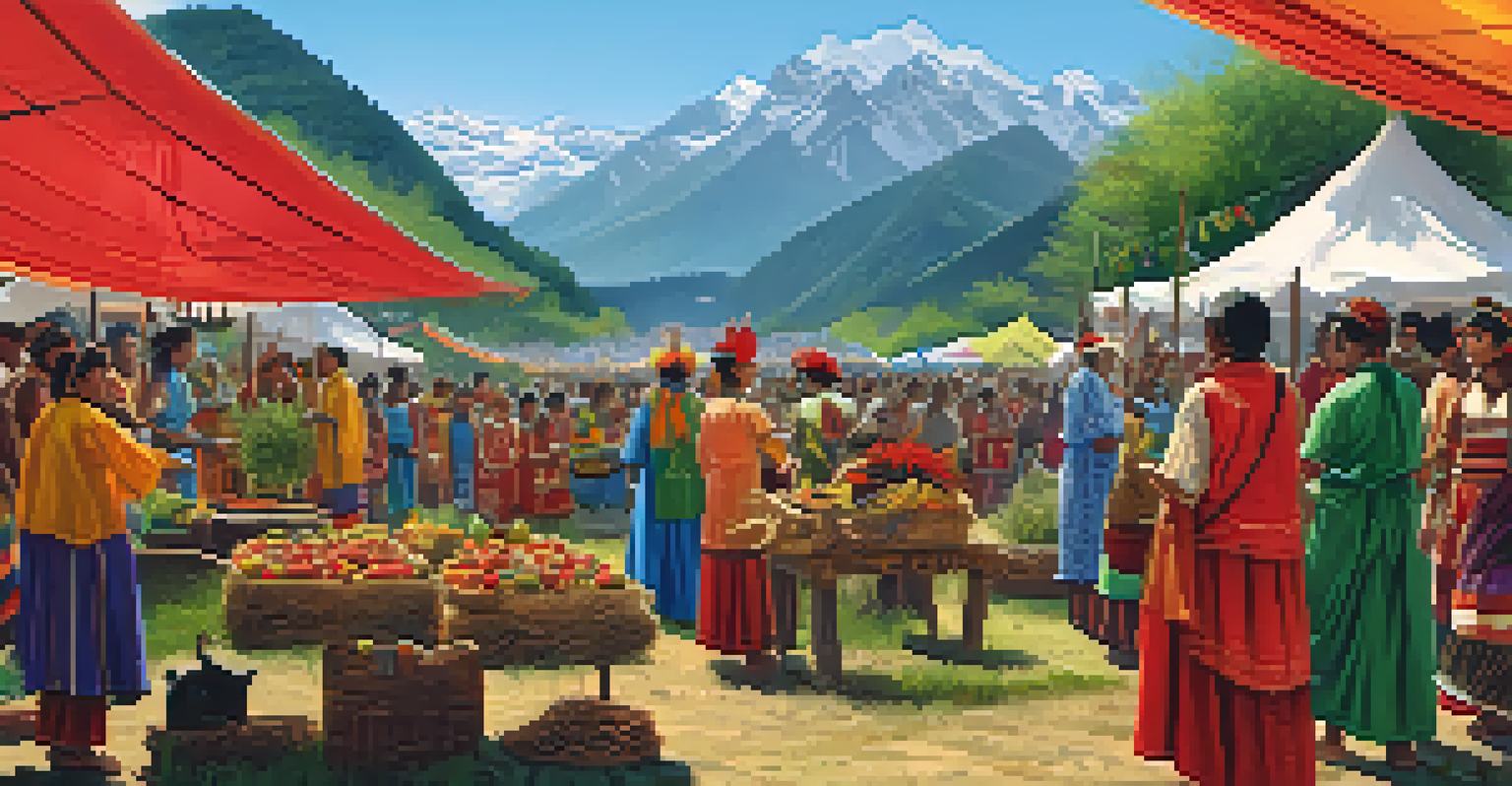The Cultural Significance of Wild Plant Harvesting Practices

Understanding Wild Plant Harvesting: A Brief Overview
Wild plant harvesting refers to the practice of gathering plants from their natural habitats, rather than cultivating them. This age-old tradition has been a fundamental part of many cultures, providing food, medicine, and materials. For instance, indigenous communities often rely on these practices for sustenance and cultural identity, showcasing a deep connection to their environment.
Wild plants are not just resources; they are our connection to the earth and to our cultural heritage.
The significance of wild plants goes beyond mere survival; they are often intertwined with cultural rituals and history. Many cultures have developed unique harvesting techniques that reflect their relationship with nature, ensuring sustainable practices that respect the ecosystem. This practice not only supports biodiversity but also preserves traditional knowledge passed down through generations.
As we explore the cultural significance of wild plant harvesting, it's essential to acknowledge its role in fostering community bonds. Gathering plants often involves collaboration and sharing, reinforcing social ties and enhancing cultural identity. Each foraged item carries stories and meanings, enriching the collective heritage of the community.
Cultural Traditions and Practices Around the World
Different cultures have their unique approaches to wild plant harvesting, often shaped by their environment and traditions. For example, in the Amazon rainforest, indigenous tribes harvest plants for medicinal purposes, using their extensive knowledge of local flora. This practice not only supports their health but also reinforces their cultural identity, as these plants are often central to their spiritual beliefs.

In contrast, the Sami people of Northern Europe have developed specific methods for gathering berries and mushrooms, which are essential for their diet. This seasonal activity is deeply embedded in their cultural practices, often accompanied by celebrations that bring families and communities together. These traditions highlight the importance of wild harvesting in maintaining cultural continuity.
Cultural Connections in Harvesting
Wild plant harvesting fosters community bonds and reflects cultural identity through shared practices and rituals.
Such practices illustrate that wild plant harvesting is not merely an economic activity; it is a vital part of cultural heritage. The rituals surrounding these gatherings often involve storytelling, music, and dance, which further enriches the cultural significance of the harvest. By participating in these traditions, communities preserve their identity and pass on valuable knowledge to future generations.
The Role of Wild Plants in Traditional Medicine
Wild plants have long been a cornerstone of traditional medicine across various cultures. Many societies have relied on specific plants for their healing properties, often using them in remedies passed down through generations. For example, the use of willow bark for pain relief is a practice that dates back centuries and has even influenced modern medicine with the development of aspirin.
The preservation of cultural heritage is essential for the survival of the diverse traditions and practices that connect people to their land.
The knowledge of medicinal plants is often rooted in cultural practices, with individuals trained to identify and harvest them sustainably. This expertise is crucial, as it not only ensures the plants' survival but also fosters a deeper understanding of their ecological roles. Traditional healers often serve as custodians of this knowledge, bridging the gap between nature and health.
As interest in natural remedies grows, many are looking back to these traditional practices for insight. This resurgence highlights the importance of preserving indigenous knowledge about wild plants, as it holds the potential for new medicinal discoveries. By valuing these practices, we can respect cultural heritage while promoting sustainable health solutions.
Sustainability in Wild Plant Harvesting Practices
Sustainability is a critical aspect of wild plant harvesting, ensuring that these practices do not deplete resources. Many cultures have developed guidelines for harvesting that prioritize the health of ecosystems, such as only taking what is needed and allowing plants to regenerate. These sustainable practices reflect a deep respect for nature and an understanding of the delicate balance within ecosystems.
For instance, the practice of selective harvesting allows for the continued growth of plants while providing necessary resources for communities. By carefully choosing which plants to harvest and when, communities can maintain their livelihoods without compromising the environment. This thoughtful approach not only supports biodiversity but also reinforces cultural values of stewardship and respect for nature.
Sustainability is Key
Sustainable harvesting practices are essential to protect ecosystems while ensuring communities can continue their traditions.
As the global community faces environmental challenges, incorporating sustainable wild harvesting practices can serve as a model for other industries. By learning from these traditional methods, we can adopt practices that benefit both people and the planet. This shift towards sustainability is essential for preserving not only the plants themselves but also the cultural traditions that depend on them.
Economic Impacts of Wild Plant Harvesting
Wild plant harvesting plays a significant role in the economies of many communities, particularly in rural areas. By gathering and selling wild plants, individuals can supplement their income while also promoting sustainable practices. This economic activity often supports local markets and fosters entrepreneurship within communities, showcasing the potential of natural resources.
Moreover, the growing interest in wild foods and herbal products has created new opportunities for businesses focused on these areas. From artisanal food producers to herbal medicine companies, the demand for wild-harvested products is rising. This trend not only boosts local economies but also encourages the preservation of traditional harvesting methods as unique selling points.
However, it's essential to balance economic growth with environmental sustainability. Communities that rely on wild plant harvesting must prioritize the health of their ecosystems to ensure long-term benefits. By promoting responsible harvesting practices, these economies can thrive while maintaining the cultural significance of their traditions.
Challenges Facing Wild Plant Harvesting Practices
Despite its cultural significance, wild plant harvesting faces numerous challenges today. Urbanization, climate change, and habitat destruction threaten the availability of wild plants, putting pressure on traditional practices. Many communities are struggling to adapt to these changes, often losing access to vital resources and traditional knowledge.
Additionally, the commercialization of wild plants can lead to overharvesting, jeopardizing the sustainability of these practices. As demand for wild-harvested products increases, it becomes crucial to implement regulations that protect both the plants and the communities dependent on them. Striking a balance between economic interests and ecological preservation is essential for the future of wild plant harvesting.
Economic Benefits of Wild Harvesting
Wild plant harvesting supports local economies and promotes entrepreneurship, highlighting the value of natural resources.
Community-led initiatives can play a vital role in addressing these challenges, empowering local individuals to advocate for their rights and resources. By fostering partnerships between communities, governments, and conservation organizations, positive change is possible. This collaborative approach can help ensure that wild plant harvesting continues to thrive in a sustainable and culturally relevant manner.
Preserving Cultural Heritage Through Wild Harvesting
Preserving the cultural heritage associated with wild plant harvesting is essential for maintaining identity and tradition. By documenting traditional practices and knowledge, communities can safeguard their cultural legacies for future generations. This preservation effort often involves storytelling, workshops, and educational programs that teach younger members about the significance of wild plants.
Cultural festivals centered around wild harvesting can also play a pivotal role in celebrating and sharing these traditions. These events allow communities to come together, showcase their knowledge, and pass on essential skills. By engaging in these activities, individuals reaffirm their connection to their heritage and raise awareness about the importance of wild plant harvesting.

Ultimately, preserving cultural heritage through wild harvesting not only enriches communities but also contributes to biodiversity and ecological health. By valuing and promoting these practices, we can foster a greater appreciation for the intricate relationships between culture, nature, and sustainable practices. This holistic approach ensures that both cultural identities and ecosystems can thrive together.